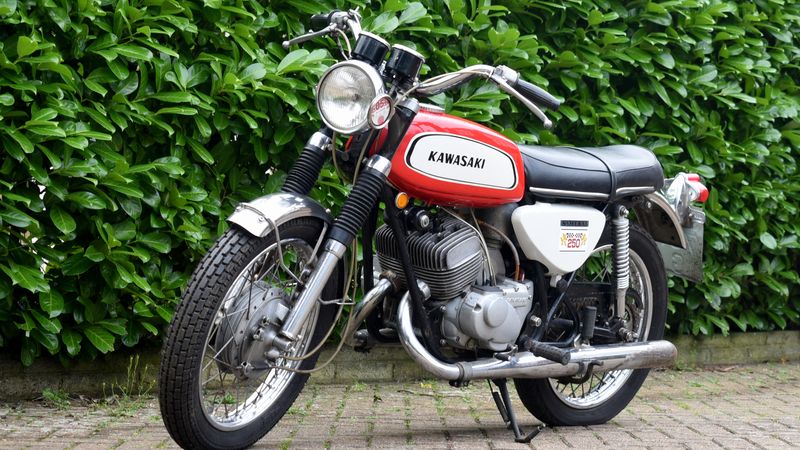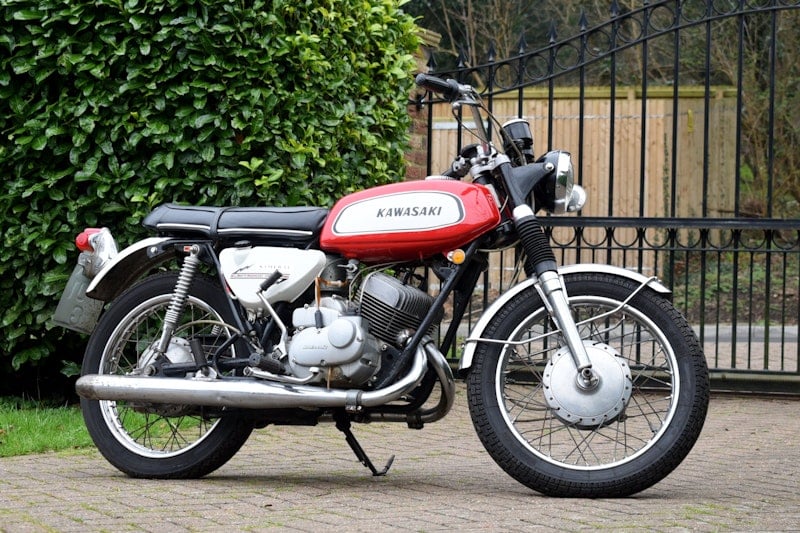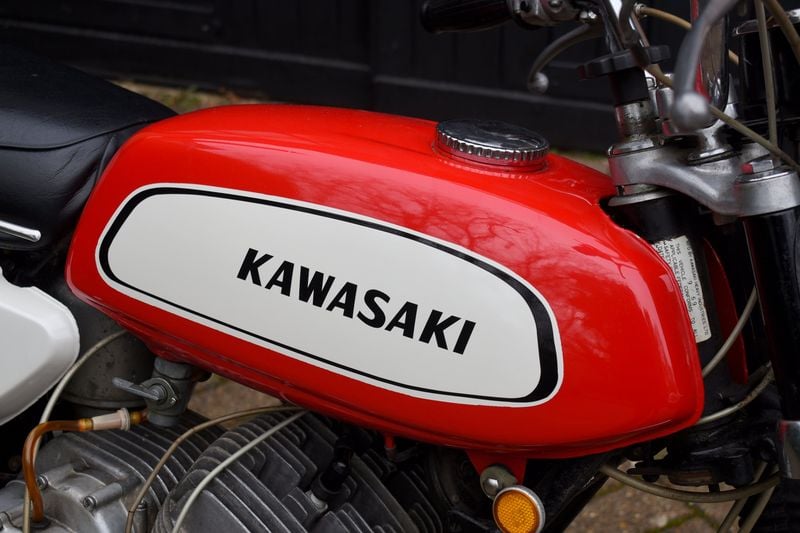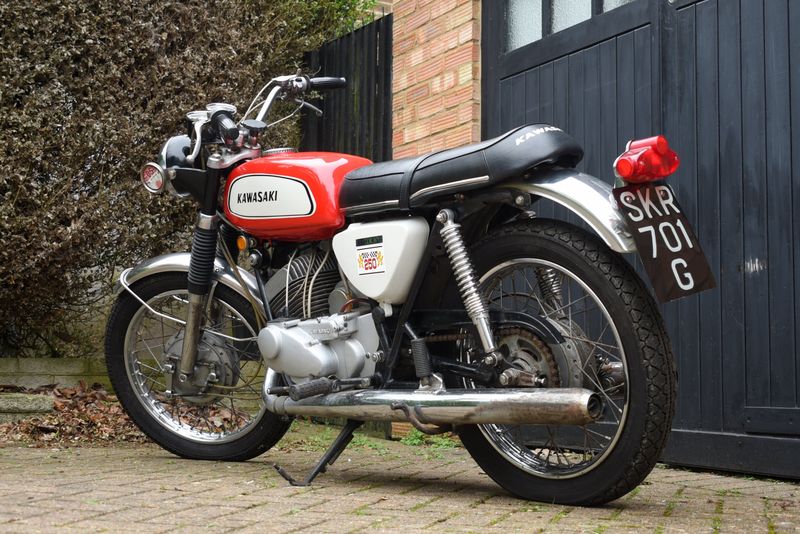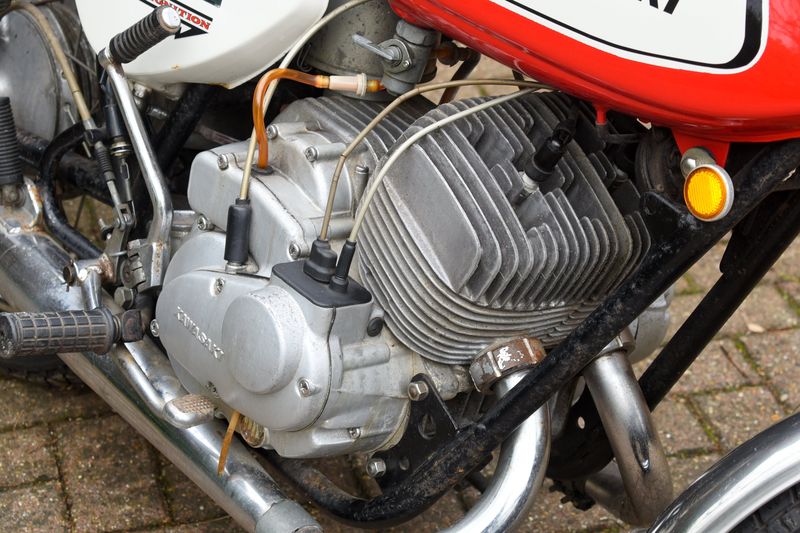Highlights
- Brilliantly characterful unrestored condition
- Very rare in Britain
- In single-family ownership since being imported in 2013
- Extremely low mileage
The Background
In the late 1960s, the reputation of Japanese bikes in the West was still being forged and, with the A1 Samurai, Kawasaki hoped to show buyers that it was a force to be reckoned with in the 250cc market. It had a bit of work to do, because its W1 625cc model, launched in 1965, did not perform well enough to be a serious rival for other bikes of the same size, and its sales and reputation suffered accordingly.
The Samurai followed with a May 1966 launch, and although it may have been smaller and less powerful than the W1, it was light for its size and gave Kawasaki exactly what it needed: something quick, agile and sporty, which would tempt people away from a Triumph Tiger Cub or the rather staid Norton Jubilee. Next to British 250s like them, the Samurai looked much more modern.
Originally only available in Candy Red or Candy Blue, the Samurai’s paint job was updated year on year to keep it looking fresh. At its launch, the stainless steel front mudguard was quite a novel feature. The look was revised for the 1970 model year with a new, angular fuel tank giving a slimmer, sleeker profile, somewhat reminiscent of the T.T. racers of the period.
Indeed, the Samurai did go racing. By December 1966 it had been developed into the A1-R, which could be seen at circuits all over the world throughout 1967 and ’68. Well-known Kawasaki racer Dave Simmonds finished fourth in the 250cc class in the 1967 Isle of Man T.T. and fifth at Assen, placing 10th overall in that year’s 250cc World Championship.
The Samurai’s 31 b.h.p. twin propelled it from 0 to 60 m.p.h. in 6.6 seconds. This placed it ahead of two of its major rivals, the Honda Dream CB250 and Suzuki T250 Hustler, which gave times of 7.6 and 7.2 seconds respectively, and it was only just eclipsed by the 6.5 seconds of the Yamaha DS6. The Samurai was discontinued in 1971 to make way for the S1 Mach I, which was ultra-modern in both looks and engineering.
The History
None of this bike’s early history is known, but its date of manufacture in September 1969 means it must have been one of the very first Samurais built to 1970 model year specification. It was imported into Britain and registered with the D.V.L.A. in June 2013 by Mr. Richard Tunbridge of Gravesend. Since then, it has never been outside Kent. In August 2013, Mr. Tunbridge passed it on to Mr. Steve Haley of Sevenoaks, uncle to the vendor.
Sadly, Mr. Haley passed away shortly after and the vendor inherited it in 2014. While he has enjoyed various classic cars and motorcycles in the past, he regrets that he never found time to ride the Samurai much, so it is now being offered for sale after eight years off the road.
The Paperwork
Bidders should note that the V5 is still in Mr. Haley’s name. That aside, the bike is sold with an M.o.T. certificate from 2013 showing no advisories and a letter from North Leicester Motorcycles confirming the year of manufacture as 1969.
The Condition
We are advised that the Kawasaki has never been restored, and we suspect that is true, although we would venture to suggest that the fuel tank and side panels may have been repainted in the past. There is a lovely patina across most of the bike, which is apparent on the engine, handlebars, frame, wheels and most ancillaries.
This is not the case so much with the tank and side panels, although they do sport a few minor paint blemishes around the edges. It might also be noted that the decals on the side panels look brand-new, which would suggest they have been renovated at some point.
The seat could conceivably be all-original, since it will not have been subjected to much wear and tear when the bike has covered fewer than 10,000 miles. Regardless of that, it looks very much like new. It has not faded anywhere, it is still exceptionally supple and the Kawasaki script at the rear doesn’t show the slightest indication of wear.
The Mechanics
While we were not able to see the bike run ourselves, the we are advised that it runs very nicely. Earlier in the year, a small leak started from the fuel tap but the vendor has renewed the seals and it no longer gives trouble.
Since the bike has been used so sparingly over its life, we are sure it is fit for many thousands of miles of pleasant motorcycling. The spotless M.o.T. certificate from 2013 suggests that it was in tip-top shape when it was last ridden. Of course, having been off the road for eight years, it may be that it needs a good service and a spot of general light recommissioning, but that shouldn’t occupy more than a weekend.
That being done, we suspect this bike will sail straight through its next M.o.T. (although it is, of course, exempt) and bring you so much happiness out on the open road.
The Appeal
The 250cc buyer was often overlooked when it came to selling bikes based on looks and sporting qualities. It was assumed that most 250 riders bought their machines solely on economic grounds. Of course, Royal Enfield recognised and built the Continental GT, which has become legendary as the bike which made 250s cool, but that was discontinued in 1967 and other manufacturers ignored the idea. That is, until the facelifted Samurai was introduced for 1970.
With its lean, racy looks, the Samurai was the coolest 250 of its day, and it wasn’t just about posing. A 0-60 time of 6.6 seconds meant it significantly outperformed most of its rivals but without the various expenses which go with larger machines, from high insurance to fuel prices. The best thing is that all of that remains true over 50 years later.
You can’t beat an unrestored bike for character, and here is one which is largely unrestored with great patina. What’s more, its extremely low mileage suggests there’s plenty of life in it too. You’ll probably not find a nicer one, if indeed you can find another one at all.
Notice to bidders
Although every care is taken to ensure this listing is as factual and transparent as possible, all details within the listing are subject to the information provided to us by the seller. Car & Classic does not take responsibility for any information missing from the listing. Please ensure you are satisfied with the vehicle description and all information provided before placing a bid.
As is normal for most auctions, this vehicle is sold as seen, and therefore the Sale of Goods Act 1979 does not apply. All bids are legally binding once placed. Any winning bidder who withdraws from a sale, is subject to our bidders fee charge. Please see our FAQs and T&C's for further information. Viewings of vehicles are encouraged, but entirely at the seller's discretion.
Please see our FAQs
here
and our Terms & Conditions
here

